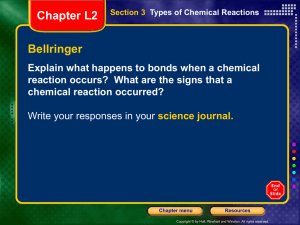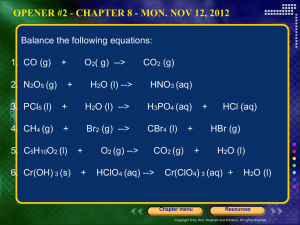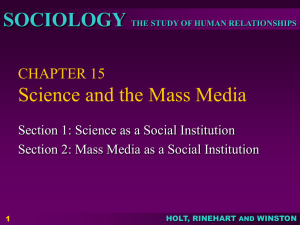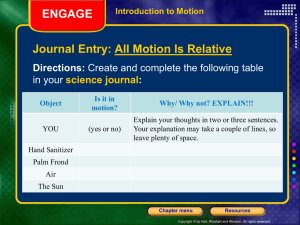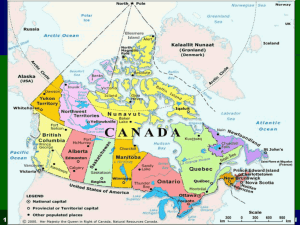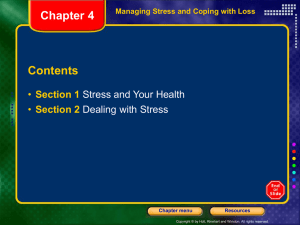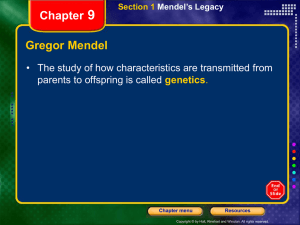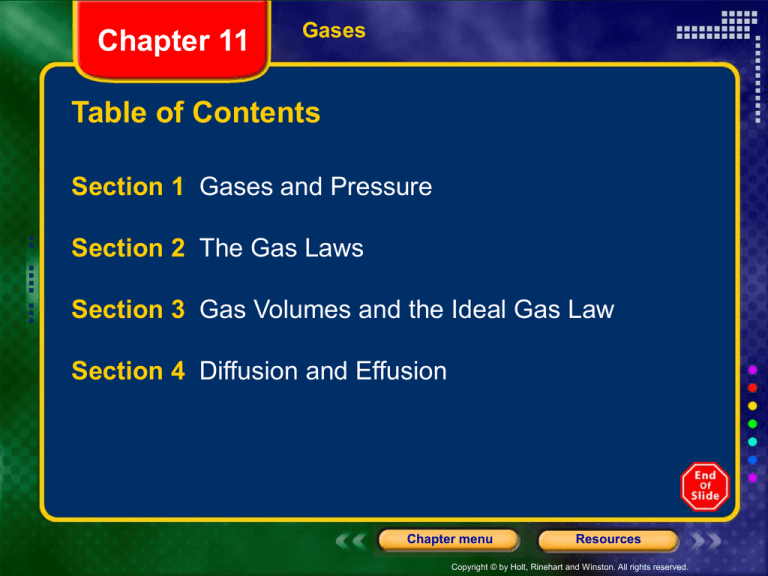
Chapter 11
Gases
Table of Contents
Section 1 Gases and Pressure
Section 2 The Gas Laws
Section 3 Gas Volumes and the Ideal Gas Law
Section 4 Diffusion and Effusion
Chapter menu
Resources
Copyright © by Holt, Rinehart and Winston. All rights reserved.
Chapter 11
Section 1 Gases and Pressure
Lesson Starter
• Make a list of gases you already know about.
• Separate your list into elements, compounds,
and mixtures.
• Share your list with the class by writing it on
the board.
Chapter menu
Resources
Copyright © by Holt, Rinehart and Winston. All rights reserved.
Chapter 11
Section 1 Gases and Pressure
Objectives
• Define pressure, give units of pressure, and describe
how pressure is measured.
• State the standard conditions of temperature and
pressure and convert units of pressure.
• Use Dalton’s law of partial pressures to calculate
partial pressures and total pressures.
Chapter menu
Resources
Copyright © by Holt, Rinehart and Winston. All rights reserved.
Chapter 11
Section 1 Gases and Pressure
Pressure and Force
• Pressure (P) is defined as the force per unit area
on a surface.
• Gas pressure is caused by collisions of the gas
molecules with each other and with surfaces with
which they come into contact.
• The pressure exerted by a gas depends on volume,
temperature, and the number of molecules present.
• The greater the number of collisions of gas molecules,
the higher the pressure will be.
Chapter menu
Resources
Copyright © by Holt, Rinehart and Winston. All rights reserved.
Chapter 11
Section 1 Gases and Pressure
Pressure and Force
• The SI unit for force is the newton, (N), the force
that will increase the speed of a one-kilogram
mass by one meter per second each second
that the force is applied.
• example: consider a person with a mass of
51 kg. At Earth’s surface, gravity has an
acceleration of 9.8 m/s2.
• The force the person exerts on the ground is
therefore 51 kg 9.8 m/s2 = 500 kg • m/s2 =
500 N
Chapter menu
Resources
Copyright © by Holt, Rinehart and Winston. All rights reserved.
Chapter 11
Section 1 Gases and Pressure
Pressure and Force
• Pressure is force per unit area, so the pressure of a
500 N person on an area of the floor that is 325 cm2
is:
500 N ÷ 325 cm2 = 1.5 N/cm2
• The greater the force on a given area, the greater
the pressure.
• The smaller the area is on which a given force acts,
the greater the pressure.
Chapter menu
Resources
Copyright © by Holt, Rinehart and Winston. All rights reserved.
Chapter 11
Section 1 Gases and Pressure
Relationship Between Pressure, Force, and
Area
Chapter menu
Resources
Copyright © by Holt, Rinehart and Winston. All rights reserved.
Chapter 11
Section 1 Gases and Pressure
Pressure and Force, continued
Measuring Pressure
• A barometer is a device used to measure
atmospheric pressure. The first barometer was
introduced by Evangelista Torricelli in the early
1600s.
• Torricelli noticed that water pumps could raise water
only to a maximum height of about 34 feet.
• He wondered why this was so, and thought the
height must depend somehow on the weight of water
compared with the weight of air.
Chapter menu
Resources
Copyright © by Holt, Rinehart and Winston. All rights reserved.
Chapter 11
Section 1 Gases and Pressure
Pressure and Force, continued
Measuring Pressure, continued
• Torricelli reasoned that if the maximum height of a
water column depended on its weight, then mercury,
which is about 14 times as dense as water, could be
raised only about 1/14 as high as water.
• He tested this idea by sealing a long glass tube at
one end and filling it with mercury. Inverting the tube
into a dish of mercury, the mercury rose to a height of
about 30 in. (760 mm), which is about 1/14 of 34 feet.
Chapter menu
Resources
Copyright © by Holt, Rinehart and Winston. All rights reserved.
Chapter 11
Section 1 Gases and Pressure
Pressure and Force, continued
Measuring Pressure, continued
• The common unit of pressure is millimeters of
mercury, symbolized mm Hg.
• A pressure of 1 mm Hg is also called 1 torr in honor of
Torricelli for his invention of the barometer.
• Pressures can also be measured in units of
atmospheres. Because the average atmospheric
pressure at sea level at 0°C is 760 mm Hg, one
atmosphere of pressure (atm) is defined as being
exactly equivalent to 760 mm Hg.
Chapter menu
Resources
Copyright © by Holt, Rinehart and Winston. All rights reserved.
Chapter 11
Section 1 Gases and Pressure
Pressure and Force, continued
Measuring Pressure, continued
• In SI, pressure is expressed in pascals. One
pascal (Pa) is defined as the pressure exerted by
a force of one newton (1 N) acting on an area of
one square meter.
• The unit is named for Blaise Pascal, a French mathematician
and philosopher who studied pressure during the seventeenth
century.
• One pascal is a very small unit of pressure, so in many
cases, it is more convenient to express pressure in
kilopascals (kPa). 1 atm is equal to 101.325 kPa.
Chapter menu
Resources
Copyright © by Holt, Rinehart and Winston. All rights reserved.
Chapter 11
Section 1 Gases and Pressure
Units of Pressure
Chapter menu
Resources
Copyright © by Holt, Rinehart and Winston. All rights reserved.
•1. In thermodynamics, the standard pressure is 100.0 kPa. What
is this value in units of atmospheres
•2. Convert a pressure of 570.0 torr to atmospheres and to kPa.
•3. The vapor pressure of water at 50.0°C is 12.33 kPa. What is
this value in millimeters of mercury?
•4. The atmospheric pressure on the surface of Mars is about
1/150 of standard pressure on Earth, or 0.00667 atm. Express this
pressure in (a) millimeters of mercury (mm Hg) and (b) kilopascals
(kPa).
Chapter 11
Section 1 Gases and Pressure
Dalton’s Law of Partial Pressures
• The pressure of each gas in a mixture is called the
partial pressure of that gas.
• John Dalton, the English chemist who proposed the
atomic theory, discovered that the pressure exerted
by each gas in a mixture is independent of that
exerted by other gases present.
• Dalton’s law of partial pressures states that the
total pressure of a gas mixture is the sum of the
partial pressures of the component gases.
Chapter menu
Resources
Copyright © by Holt, Rinehart and Winston. All rights reserved.
Chapter 11
Section 1 Gases and Pressure
Dalton’s Law of Partial Pressures, continued
Gases Collected by Water Displacement
• Gases produced in the laboratory are often collected
over water. The gas produced by the reaction
displaces the water in the reaction bottle.
• Dalton’s law of partial pressures can be applied to
calculate the pressures of gases collected in this
way.
• Water molecules at the liquid surface evaporate and
mix with the gas molecules. Water vapor, like other
gases, exerts a pressure known as vapor pressure.
Chapter menu
Resources
Copyright © by Holt, Rinehart and Winston. All rights reserved.
Chapter 11
Section 1 Gases and Pressure
Dalton’s Law of Partial Pressures, continued
Gases Collected by Water Displacement, continued
• To determine the pressure of a gas inside a collection
bottle, you would use the following equation, which is
an instance of Dalton’s law of partial pressures.
Patm = Pgas + PH O
2
• If you raise the bottle until the water levels inside and
outside the bottle are the same, the total pressure
outside and inside the bottle will be the same.
• Reading the atmospheric pressure from a barometer
and looking up the value of PH O at the temperature of
the experiment in a table, you can calculate Pgas.
2
Chapter menu
Resources
Copyright © by Holt, Rinehart and Winston. All rights reserved.
Chapter 11
Section 1 Gases and Pressure
Particle Model for a Gas Collected Over Water
Chapter menu
Resources
Copyright © by Holt, Rinehart and Winston. All rights reserved.
•1. Helium gas is collected over water at 25°C. What is the partial
pressure of the helium, given that the barometric pressure is
750.0 mm Hg?
•2. Oxygen gas is collected by water displacement from the
decomposition of hydrogen peroxide using manganese(IV) oxide
as a catalyst. During the experiment, the barometric pressure is
755 mm Hg and the temperature was 24.0°C. What is the partial
pressure of the oxygen collected?
•3. A student has stored 250 mL of helium gas over water on a
cool day when the temperature in the room reads 20.5°C. If the
barometric pressure in the room is 768 mm Hg, what is the
pressure of the helium gas in its container?
•4. Some hydrogen gas is collected over water at 23.5°C. The
gas-collecting bottle is placed into a large container of water. The
levels of water inside and outside the gas-collecting bottle are
adjusted to be the same. The partial pressure of the hydrogen is
738.6 torr. What is the barometric pressure at the time the gas is
collected?
Chapter 11
Section 2 The Gas Laws
Objectives
• Use the kinetic-molecular theory to explain the
relationships between gas volume, temperature and
pressure.
• Use Boyle’s law to calculate volume-pressure changes
at constant temperature.
• Use Charles’s law to calculate volume-temperature
changes at constant pressure.
Chapter menu
Resources
Copyright © by Holt, Rinehart and Winston. All rights reserved.
Chapter 11
Section 2 The Gas Laws
Objectives, continued
• Use Gay-Lussac’s law to calculate pressuretemperature changes at constant volume.
• Use the combined gas law to calculate volumetemperature-pressure changes.
Chapter menu
Resources
Copyright © by Holt, Rinehart and Winston. All rights reserved.
Chapter 11
Section 2 The Gas Laws
Boyle’s Law: Pressure-Volume Relationship
• Robert Boyle discovered that doubling the pressure
on a sample of gas at constant temperature reduces
its volume by one-half.
• This is explained by the kinetic-molecular theory:
• The pressure of a gas is caused by moving molecules
hitting the container walls.
• If the volume of a gas is decreased, more collisions will
occur, and the pressure will therefore increase.
• Likewise, if the volume of a gas is increased, less
collisions will occur, and the pressure will decrease.
Chapter menu
Resources
Copyright © by Holt, Rinehart and Winston. All rights reserved.
Chapter 11
Section 2 The Gas Laws
Boyle’s Law: Pressure-Volume Relationship
• Boyle’s Law states that
the volume of a fixed
mass of gas varies
inversely with the
pressure at constant
temperature.
• Plotting the values of
volume versus pressure
for a gas at constant
temperature gives a
curve like that shown at
right.
Chapter menu
Resources
Copyright © by Holt, Rinehart and Winston. All rights reserved.
Chapter 11
Section 2 The Gas Laws
Boyle’s Law: Pressure-Volume Relationship
• Mathematically, Boyle’s law can be expressed as:
PV = k
• P is the pressure, V is the volume, and k is a
constant. Since P and V vary inversely, their product
is a constant.
Chapter menu
Resources
Copyright © by Holt, Rinehart and Winston. All rights reserved.
Chapter 11
Section 2 The Gas Laws
Boyle’s Law: Pressure-Volume Relationship,
continued
• Because two quantities that are equal to the same
thing are equal to each other, Boyle’s law can also
be expressed as:
P1V1 = P2V2
• P1 and V1 represent initial conditions, and P2 and
V2 represent another set of conditions.
• Given three of the four values P1, V1, P2, and V2,
you can use this equation to calculate the fourth
value for a system at constant temperature.
Chapter menu
Resources
Copyright © by Holt, Rinehart and Winston. All rights reserved.
•1. A weather balloon with a volume of 1.375 L is released from
Earth’s surface at sea level. What volume will the balloon occupy
at an altitude of 20.0 km, where the air pressure is 10.0 kPa?
Assume no temperature change.
•2. A gas has a pressure of 1.26 atm and occupies a volume of
7.40 L. If the gas is compressed to a volume of 2.93 L, what will
its pressure be? Assume no temperature change.
•3. As divers know, the pressure exerted by water increases by
about 100 kPa with every 10.2 m of depth. This means that at
10.2 m below the surface, the pressure is 201 kPa, at 20.4 m, the
pressure is 301 kPa, and so forth. If the volume of a balloon is 3.5
L at STP, what would its volume be at 51 m below the water’s
surface? Assume no temperature change.
•4. A balloon contains 375 mL of air at a pressure of 730. torr.
What is the pressure of the air in the balloon if the volume is
reduced to 250. mL at constant temperature? Assume no air
enters or escapes during compression.
Chapter 11
Section 2 The Gas Laws
Charles’s Law: Volume-Temperature
Relationship, continued
• If pressure is constant, gases expand when heated.
• When the temperature increases, the volume of a
fixed number of gas molecules must increase if
the pressure is to stay constant.
• At the higher temperature, the gas molecules
move faster. They collide with the walls of the
container more frequently and with more force.
• The volume of a flexible container must then
increase in order for the pressure to remain the
same.
Chapter menu
Resources
Copyright © by Holt, Rinehart and Winston. All rights reserved.
Chapter 11
Section 2 The Gas Laws
Charles’s Law: Volume-Temperature
Relationship, continued
• The quantitative relationship between volume and
temperature was discovered by the French scientist
Jacques Charles in 1787.
• Charles found that the volume changes by 1/273 of the
original volume for each Celsius degree, at constant
pressure and at an initial temperature of 0°C.
• The temperature –273.15°C is referred to as absolute
zero, and is given a value of zero in the Kelvin
temperature scale. The relationship between the two
temperature scales is K = 273.15 + °C.
Chapter menu
Resources
Copyright © by Holt, Rinehart and Winston. All rights reserved.
Chapter 11
Section 2 The Gas Laws
Charles’s Law: Volume-Temperature Relationship,
continued
• Charles’s law states
that the volume of a
fixed mass of gas at
constant pressure varies
directly with the Kelvin
temperature.
• Gas volume and Kelvin
temperature are directly
proportional to each
other at constant
pressure, as shown at
right.
Chapter menu
Resources
Copyright © by Holt, Rinehart and Winston. All rights reserved.
Chapter 11
Section 2 The Gas Laws
Charles’s Law: Volume-Temperature
Relationship, continued
• Mathematically, Charles’s law can be expressed as:
V kT or
V
k
T
• V is the volume, T is the Kelvin temperature, and
k is a constant. The ratio V/T for any set of volumetemperature values always equals the same k.
• This equation reflects the fact that volume and
temperature are directly proportional to each other
at constant pressure.
Chapter menu
Resources
Copyright © by Holt, Rinehart and Winston. All rights reserved.
Chapter 11
Section 2 The Gas Laws
Charles’s Law: Volume-Temperature
Relationship, continued
• The form of Charles’s law that can be applied directly to
most volume-temperature gas problems is:
V1
T1
V2
T2
• V1 and T1 represent initial conditions, and V2 and T2
represent another set of conditions.
• Given three of the four values V1, T1, V2, and T2, you
can use this equation to calculate the fourth value for
a system at constant pressure.
Chapter menu
Resources
Copyright © by Holt, Rinehart and Winston. All rights reserved.
Chapter 11
Section 2 The Gas Laws
Gay-Lussac’s Law: Pressure-Temperature
Relationship
• At constant volume, the pressure of a gas increases
with increasing temperature.
• Gas pressure is the result of collisions of
molecules with container walls.
• The energy and frequency of collisions depend
on the average kinetic energy of molecules.
• Because the Kelvin temperature depends directly
on average kinetic energy, pressure is directly
proportional to Kelvin temperature.
Chapter menu
Resources
Copyright © by Holt, Rinehart and Winston. All rights reserved.
Chapter 11
Section 2 The Gas Laws
Gay-Lussac’s Law: Pressure-Temperature
Relationship, continued
• Gay-Lussac’s law
states that the pressure
of a fixed mass of gas at
constant volume varies
directly with the Kelvin
temperature.
• This law is named after
Joseph Gay-Lussac,
who discovered it in
1802.
Chapter menu
Resources
Copyright © by Holt, Rinehart and Winston. All rights reserved.
•1. A helium-filled balloon has a volume of 2.75 L at 20.°C. The
volume of the balloon decreases to 2.46 L after it is placed outside
on a cold day. What is the outside temperature in K? in °C?
•2. A gas at 65°C occupies 4.22 L. At what Celsius temperature
will the volume be 3.87 L, assuming the same pressure?
•3. A sample of methane has a volume of 56.2 mL at a
temperature of 12°C. At what Celsius temperature will the gas
occupy a volume of 60.0 mL?
•4. A helium filled balloon has a volume of 433 mL at a
temperature 25.0°C. It is taken outside and put into a car, then left
for 3 hours at a temperature of 2.0°C. Assuming no helium
escapes and the atmospheric pressure remains constant, what
will be the volume of the balloon when the driver of the car
returns?
Chapter 11
Section 2 The Gas Laws
Gay-Lussac’s Law: Pressure-Temperature
Relationship, continued
• Mathematically, Gay-Lussac’s law can be expressed
as:
P
P kT or
k
T
• P is the pressure, T is the Kelvin temperature, and
k is a constant. The ratio P/T for any set of volumetemperature values always equals the same k.
• This equation reflects the fact that pressure and
temperature are directly proportional to each other
at constant volume.
Chapter menu
Resources
Copyright © by Holt, Rinehart and Winston. All rights reserved.
Chapter 11
Section 2 The Gas Laws
Gay-Lussac’s Law: Pressure-Temperature
Relationship, continued
• The form of Gay-Lussac’s law that can be applied
directly to most pressure-temperature gas problems is:
P1
T1
P2
T2
• P1 and T1 represent initial conditions, and P2 and T2
represent another set of conditions.
• Given three of the four values P1, T1, P2, and T2, you
can use this equation to calculate the fourth value for
a system at constant pressure.
Chapter menu
Resources
Copyright © by Holt, Rinehart and Winston. All rights reserved.
•1. The temperature within an automobile tire at the beginning of a
long trip is 25°C. At the conclusion of the trip, the tire has a
pressure of 1.80 atm. What is the final Celsius temperature within
the tire if its original pressure was 1.75 atm?
•2. A sample of gas in a closed container at a temperature of
100.0°C and a pressure of 3.0 atm is heated to 300.0°C. What
pressure does the gas exert at the higher temperature?
•3. Before a trip from New York to Boston, the pressure in an
automobile tire is 3.0 atm at 20.0°C. At the end of the trip, the
pressure is 3.3 atm. What is the new Celsius temperature of the
air inside the tire, assuming constant volume?
•4. A student collects a sample of oxygen gas at a temperature of
45°C and a pressure of 0.907 atm. What will the pressure of the
oxygen be when it cools to a temperature of 21°C?
Chapter 11
Section 2 The Gas Laws
Summary of the Basic Gas Laws
Chapter menu
Resources
Copyright © by Holt, Rinehart and Winston. All rights reserved.
Chapter 11
Section 2 The Gas Laws
The Combined Gas Law
• Boyle’s law, Charles’s law, and Gay-Lussac’s law can
be combined into a single equation that can be used
for situations in which temperature, pressure, and
volume, all vary at the same time.
• The combined gas law expresses the relationship
between pressure, volume, and temperature of a
fixed amount of gas. It can be expressed as follows:
PV
k
T
Chapter menu
Resources
Copyright © by Holt, Rinehart and Winston. All rights reserved.
Chapter 11
Section 2 The Gas Laws
The Combined Gas Law, continued
• The combined gas law can also be written as follows.
P1V1
T1
P2V2
T2
• The subscripts 1 and 2 represent two different sets of
conditions. As in Charles’s law and Gay-Lussac’s law,
T represents Kelvin temperature.
• Each of the gas laws can be obtained from the
combined gas law when the proper variable is
kept constant.
Chapter menu
Resources
Copyright © by Holt, Rinehart and Winston. All rights reserved.
Chapter 11
Section 3 Gas Volumes and the
Ideal Gas Law
Lesson Starter
• Write balanced chemical equations for the two
chemical reactions indicated below.
hydrogen gas + oxygen gas water vapor
(2 liters)
(1 liter)
(2 liters)
hydrogen gas + chlorine gas hydrogen chloride
(1 liter)
(1 liter)
(2 liters)
• Compare the balanced equations with the
expressions above. What do you notice?
Chapter menu
Resources
Copyright © by Holt, Rinehart and Winston. All rights reserved.
Chapter 11
Section 3 Gas Volumes and the
Ideal Gas Law
Objectives
• State the law of combining volumes.
• State Avogadro’s law and explain its significance.
• Define standard molar volume of a gas and use it to
calculate gas masses and volumes.
• State the ideal gas law.
• Using the ideal gas law, calculate pressure, volume,
temperature, or amount of gas when the other three
quantities are known.
Chapter menu
Resources
Copyright © by Holt, Rinehart and Winston. All rights reserved.
Chapter 11
Section 3 Gas Volumes and the
Ideal Gas Law
Measuring and Comparing the Volumes of
Reacting Gases
• In the early 1800s, French chemist Joseph GayLussac observed that 2 L of hydrogen can react with
1 L of oxygen to form 2 L of water vapor.
hydrogen gas + oxygen gas water vapor
2 L (2 volumes) 1 L (1 volume) 2 L (2 volumes)
• The reaction shows a simple 2:1:2 ratio in the
volumes of reactants and products. This same ratio
applies to any volume proportions: for example,
2 mL, 1 mL, and 2 mL; or 600 L, 300 L, and 600 L.
Chapter menu
Resources
Copyright © by Holt, Rinehart and Winston. All rights reserved.
Chapter 11
Section 3 Gas Volumes and the
Ideal Gas Law
Measuring and Comparing the Volumes of
Reacting Gases
• The same simple and definite volume proportions
can be observed in other gas reactions.
hydrogen gas + chlorine gas hydrogen chloride gas
1 L (2 volumes) 1 L (1 volume)
2 L (2 volumes)
• Gay-Lussac’s law of combining volumes of gases
states that at constant temperature and pressure, the
volumes of gaseous reactants and products can be
expressed as ratios of small whole numbers.
Chapter menu
Resources
Copyright © by Holt, Rinehart and Winston. All rights reserved.
Chapter 11
Section 3 Gas Volumes and the
Ideal Gas Law
Avogadro’s Law
• In 1811, Amedeo Avogadro explained Gay-Lussac’s
law of combining volumes of gases without violating
Dalton’s idea of indivisible atoms.
• Avogadro reasoned that, instead of always being in
monatomic form when they combine to form products,
gas molecules can contain more than one atom.
• He also stated an idea known today as Avogadro’s
law. The law states that equal volumes of gases at
the same temperature and pressure contain equal
numbers of molecules.
Chapter menu
Resources
Copyright © by Holt, Rinehart and Winston. All rights reserved.
Chapter 11
Section 3 Gas Volumes and the
Ideal Gas Law
Avogadro’s Law, continued
• Avogadro’s law also indicates that gas volume is
directly proportional to the amount of gas, at a given
temperature and pressure.
• The equation for this relationship is shown below,
where V is the volume, k is a constant, and n is the
amount of moles of the gas.
V = kn
Chapter menu
Resources
Copyright © by Holt, Rinehart and Winston. All rights reserved.
Chapter 11
Section 3 Gas Volumes and the
Ideal Gas Law
Avogadro’s Law, continued
• Avogadro’s law applies to the combining volumes in
gas reactions, and helped him to deduce chemical
formulas in reactions.
• Dalton had guessed that the formula for water
was HO, but Avogadro’s reasoning established
that water must contain twice as many H atoms as
O atoms because of the volume ratios in which the
gases combine:
hydrogen gas + oxygen gas water vapor
2 L (2 volumes) 1 L (1 volume) 2 L (2 volumes)
Chapter menu
Resources
Copyright © by Holt, Rinehart and Winston. All rights reserved.
Chapter 11
Section 3 Gas Volumes and the
Ideal Gas Law
Avogadro’s Law, continued
• Given Avogadro’s law, the simplest possible chemical
formula for a water molecule indicated two hydrogen
atoms and one oxygen atom.
hydrogen gas + oxygen gas water vapor
(2 volumes)
(1 volume)
(2 volumes)
2H2 (g) O2 (g) 2H2O(g)
• Avogadro’s idea that some gases, such as hydrogen and
oxygen, must be diatomic, was thus consistent with Avogadro’s
law and a chemical formula for water of H2O.
Chapter menu
Resources
Copyright © by Holt, Rinehart and Winston. All rights reserved.
Chapter 11
Section 3 Gas Volumes and the
Ideal Gas Law
Molar Volume of a Gas
• Recall that one mole of a substance contains a number of
particles equal to Avogadro’s constant (6.022 1023).
• example: one mole of oxygen, O2, contains 6.022 1023
diatomic molecules.
• According to Avogadro’s law, one mole of any gas will occupy
the same volume as one mole of any other gas at the same
conditions, despite mass differences.
• The volume occupied by one mole of gas at STP is known as
the standard molar volume of a gas,
which is 24.414 10 L (rounded to 22.4 L).
Chapter menu
Resources
Copyright © by Holt, Rinehart and Winston. All rights reserved.
Chapter 11
Section 3 Gas Volumes and the
Ideal Gas Law
Molar Volume of a Gas, continued
• Knowing the volume of a gas, you can use the
conversion factor 1 mol/22.4 L to find the moles (and
therefore also mass) of a given volume of gas at
STP.
• example: at STP, 5.00 L of gas
1 mol
0.223 mol of gas
22.4 L
• You can also use the molar volume of a gas to find
the volume, at STP, of a known number of moles or a
known mass of gas.
• example: at STP, 0.768 mol of gas 22.4 L 17.2 L of gas
1 mol
Chapter menu
Resources
Copyright © by Holt, Rinehart and Winston. All rights reserved.
Chapter 11
Section 3 Gas Volumes and the
Ideal Gas Law
Gas Stoichiometry
• Gay-Lussac’s law of combining volumes of gases and
Avogadro’s law can be applied in calculating the stoichiometry of
reactions involving gases.
• The coefficients in chemical equations of gas reactions reflect
not only molar ratios, but also volume ratios (assuming
conditions remain the same).
• example—reaction of carbon dioxide formation:
2CO(g) + O2(g) 2CO2(g)
2 molecules
2 mole
2 volumes
1 molecule
1 mole
1 volume
2 molecules
2 mol
2 volumes
Chapter menu
Resources
Copyright © by Holt, Rinehart and Winston. All rights reserved.
Chapter 11
Section 3 Gas Volumes and the
Ideal Gas Law
Gas Stoichiometry, continued
2CO(g)
+
2 molecules
2 mole
2 volumes
O2(g)
2CO2(g)
1 molecule
2 molecules
1 mole
2 mol
1 volume
2 volumes
• You can use the volume ratios as conversion
factors in gas stoichiometry problems as you would
mole ratios:
1 volume O2
2 volumes CO
or
1 volume O2
2 volumes CO
2 volumes CO2
2 volumes CO
or
2 volumes CO2
2 volumes CO
etc….
Chapter menu
Resources
Copyright © by Holt, Rinehart and Winston. All rights reserved.
Chapter 11
Section 3 Gas Volumes and the
Ideal Gas Law
The Ideal Gas Law
• You have learned about equations describing the
relationships between two or three of the four
variables—pressure, volume, temperature, and
moles—needed to describe a gas sample at a time.
• All of the gas laws you have learned thus far can be
combined into a single equation, the ideal gas law:
the mathematical relationship among pressure,
volume, temperature, and number of moles of a gas.
• It is stated as shown below, where R is a constant:
PV = nRT
Chapter menu
Resources
Copyright © by Holt, Rinehart and Winston. All rights reserved.
Chapter 11
Section 3 Gas Volumes and the
Ideal Gas Law
The Ideal Gas Law, continued
The Ideal Gas Constant
• In the equation representing the ideal gas law, the
constant R is known as the ideal gas constant.
• Its value depends on the units chosen for pressure, volume,
and temperature in the rest of the equation.
• Measured values of P, V, T, and n for a gas at near-ideal
conditions can be used to calculate R:
R
PV (1 atm)(22.414 10 L)
L atm
0.082 058
nT
(1 mol)(273.15 K)
mol K
Chapter menu
Resources
Copyright © by Holt, Rinehart and Winston. All rights reserved.
Chapter 11
Section 3 Gas Volumes and the
Ideal Gas Law
The Ideal Gas Law, continued
The Ideal Gas Constant, continued
• The calculated value of R is usually rounded to
0.0821 (L•atm)/(mol•K).
• Use this value in ideal gas law calculations when the
volume is in liters, the pressure is in atmospheres, and
the temperature is in kelvins.
• The ideal gas law can be applied to determine the
existing conditions of a gas sample when three of the
four values, P, V, T, and n, are known.
• Be sure to match the units of the known quantities
and the units of R.
Chapter menu
Resources
Copyright © by Holt, Rinehart and Winston. All rights reserved.
Chapter 11
Section 3 Gas Volumes and the
Ideal Gas Law
Numerical Values of the Gas Constant
Chapter menu
Resources
Copyright © by Holt, Rinehart and Winston. All rights reserved.
Chapter 11
Section 4 Diffusion and Effusion
Objectives
• Describe the process of diffusion.
• State Graham’s law of effusion.
• State the relationship between the average
molecular velocities of two gases and their molar
masses.
Chapter menu
Resources
Copyright © by Holt, Rinehart and Winston. All rights reserved.
Chapter 11
Section 4 Diffusion and Effusion
Diffusion and Effusion
• The constant motion of gas molecules causes them
to spread out to fill any container they are in.
• The gradual mixing of two or more gases due to their
spontaneous, random motion is known as diffusion.
• Effusion is the process whereby the molecules of a
gas confined in a container randomly pass through a
tiny opening in the container.
Chapter menu
Resources
Copyright © by Holt, Rinehart and Winston. All rights reserved.
Chapter 11
Section 4 Diffusion and Effusion
Graham’s Law of Effusion
• Rates of effusion and diffusion depend on the relative
velocities of gas molecules. The velocity of a gas
varies inversely with the square root of its molar
mass.
• Recall that the average kinetic energy of the molecules in
1
any gas depends only the temperature and equals mv 2 .
2
• For two different gases, A and B, at the same temperature,
the following relationship is true.
1
1
2
MAv A MBv B 2
2
2
Chapter menu
Resources
Copyright © by Holt, Rinehart and Winston. All rights reserved.
Chapter 11
Section 4 Diffusion and Effusion
Graham’s Law of Effusion
• From the equation relating the kinetic energy of two
different gases at the same conditions, one can
derive an equation relating the rates of effuses of two
gases with their molecular mass:
MB
rate of effusion of A
rate of effusion of B
MA
• This equation is known as Graham’s law of
effusion, which states that the rates of effusion
of gases at the same temperature and pressure
are inversely proportional to the square roots of
their molar masses.
Chapter menu
Resources
Copyright © by Holt, Rinehart and Winston. All rights reserved.
Chapter 11
Section 4 Diffusion and Effusion
Graham’s Law
Chapter menu
Resources
Copyright © by Holt, Rinehart and Winston. All rights reserved.
End of Chapter 11 Show
Chapter menu
Resources
Copyright © by Holt, Rinehart and Winston. All rights reserved.

